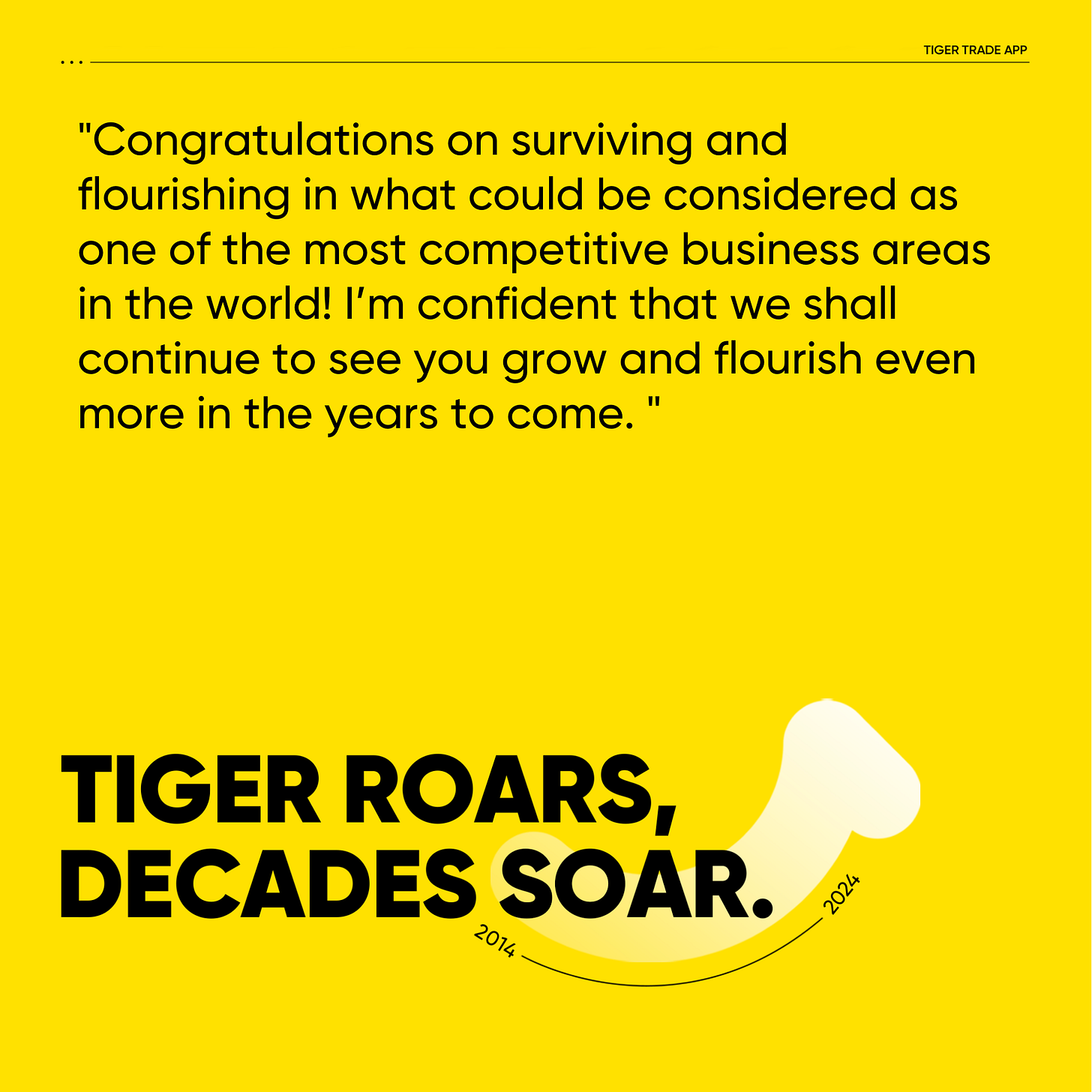My Interview with the Tiger Brokers Community
A heart-to-heart in the course of Tiger's 10th Anniversary celebrations
Singapore-headquartered Tiger Brokers has gone from strength to strength over the past 10 years leading to a Community platform comprised of 10 million users globally, triple-digit year-on-year customer growth in Singapore and Hong Kong along with net asset inflows of US$16-18,000 per customer, as well as a growing footprint in Australia and New Zealand. My 3+ years of engagement with the Community platform — via 106 articles currently — has been a very interesting one and led to an interview with the Community Team which was published on the platform. Here is the full Q&A along with the posters accompanying it on the Tiger platform. Read on!
Q: Can you share a bit about your investment journey and what kind of investor are you?
A: In the present, my journey is both institutional and personal: I lead research for a European investment management company whose products are among the most traded instruments in the London Stock Exchange (LSE). Meanwhile, I’m also an active personal investor.
My beginning might be considered a bit late: I graduated with a bachelor’s degree in engineering with zero awareness of (or interest in) markets. An appraisal of my performance in college led me to realize that my best scores were in subjects related to mathematics and statistics. I looked around the professional landscape and decided to enter the financial services industry. To me, that meant more education: I went on to earn two master’s degrees – one in quantitative finance and the other an MBA. My personal journey into investments began alongside my graduate studies and continued henceforth. Before that, I had made modest purchases in stocks such as Infosys and TCS – two bellwethers for India’s IT services exports that I felt were the “safest” bets.
As I studied and subsequently worked my way through the likes of Barclays Capital and Nasdaq, I became a more sophisticated investor: I typically do “buy and hold” strategies in some markets/subclasses (examples: India and U.S. dividend champions, respectively) and I also do a lot of “trajectory plays” (i.e. betting on price movements rather than long-term outlook) on U.S. stocks.
Q: Reflecting on your time with Tiger Brokers, how long have you been with Tiger Brokers? How did you know TigerTrade? What aspects of the Tiger community have been particularly valuable to you?
A: I’ve been with Tiger Brokers for almost three years now. I had heard of the platform from a handful of retail investors in different parts of the world (plus Tiger’s standing in Singapore makes it stand out in media coverage).
The Tiger Community is unique in that it combines social messaging for investors with a trading “front end”. Its social messaging/networking form is quite underrated: trends, hype and investment-related content are important tools for retail investors to level up relative to professional investment firms and their research teams.
Q: Among the array of features offered by the Tiger APP, which one do you find yourself utilizing most frequently? Which products do you primarily trade? Such as US stocks, options or others?
A: I use the Community feature the most to figure out what the hottest and most talked-about trends are. It’s interesting how so many people talk about options strategies (a classical form of “trajectory play”) here; this is refreshing. Users on investment community platforms elsewhere tend to show a marked disdain for “day traders” which is unhealthy. Trajectory plays lend a hand in price discovery and consensus building: without speculative bets, no market can continue in perpetuity.
Given my conviction in “trajectory plays” with US stocks, options are certainly one way of doing so. However, I choose leveraged ETFs (or ETPs) more often which have almost no likelihood of margin calls, etc. and can be exited as and when required by simply selling one’s stake in said ETPs.
Q: Considering your investment experience, what's the most significant lesson you've learned in recent years that has profoundly impacted your approach to investing?
A: As an academic, one theory I learnt was “market participants are rational; thereby markets are rational”. It’s just that: a theory. As a species, we haven’t evolved into beings of pure reason yet. For example: if markets were rational, Tesla’s share price (i.e. one of the most watched stocks in the world) wouldn’t have risen 10% just because Elon Musk tweeted that he will take the company private at $420 – an obvious joke about marijuana. Reason asserts that until a formal proposal is made to and subsequently approved by the board, there is no cause for taking this seriously. But that isn’t how it all played out.
There are numerous such examples. When it comes to the U.S. market, overvaluation is writ large and volatility is inevitable.
Q: Could you recount a particularly memorable investment you've made in the past few years?
A: I tend to be very sparing with the candidate pool for my “buy and hold” portfolio. Into this, I added a large number of shares of Indian aerospace company Hindustan Aeronautics Limited about four years ago after doing a deep read into news about the company and press releases. Since then, my investment is now more than 1,000% relative to initial value without counting the regular dividends paid out.
In my “trajectory play” portfolio, my convictions on Tesla’s imminent price inversion (which I had documented often on Tiger Community) have particularly paid off this year via “inverse ETPs”, which have nearly the same payout structure as a short position but without the margin risk.
Q: In light of recent market dynamics, are there any emerging insights or trends catching your attention? Any key focuses or investment goals for the second half of the year?
A: There are increasingly more strident assertions being made of a “hard landing” in the U.S. market (coincidentally, right as Americans march into election mode). It’s a minority view at least on mainstream media right now but rising default rates on loans, non-negative Month on Month (MoM) and Year-on-Year (YoY) trends in the Consumer Price Index (CPI), etc. indicate that forward outlooks should be weaker. The markets’ peaks and troughs in nearly-regular week-on-week succession, despite these factors, are a matter of concern.
China’s market is clouded in uncertainty. This is implied by several factors: the relaxation of “hukou” permits for residency largely propping up real estate rates in Beijing, Shanghai and Guangzhou while other major metropolitan regions trail, the easing of both luxury goods as well as casual spending by younger consumers, and infrastructure spends requiring additional bond issuances by local government bodies indicate that some sort of “landing” among Chinese equities is also imminent.
However, the world isn’t what it used to be: just like the end of the Cold War over 30 years ago meant that it wasn’t all about the U.S. and the Soviet Union any more, more and more investors are gloaming on to the fact that the investment universe isn’t all about America and China as well.
Q: Have you explored Tiger Brokers' fund mall or other wealth products? If so, what kind of funds do you hold on Tiger Brokers?
A: I tend to buy mutual funds (which are essentially discretionary “buy and hold” vehicles) in certain markets only so I haven’t used “Fund Mall” a lot. However, I find the rates offered to be reasonable.
Buying funds in Singapore is intuitively a meaningful strategy since equity valuations on Singaporean stocks tend to be steady and hype-free. Thus, availing the services of a portfolio management team comprised of bright and experienced individuals from around the world for a modest fee to generate steady returns on a long-term basis is the most effective form of resource allocation. It’s a highly competitive industry with a myriad of choices to choose from – making it a buyer’s market.
Q: What features of Tiger Trade do you find most appealing, and why? Please share three aspects that particularly resonate with you. Additionally, what are your expectations for Tiger as it moves forward?
A: The three features I like the most are: (1) automatable functionality for fund subscription, (2) the rather interesting – and often quirky – means of balance reporting and (3) the news feed.
I would like to see additional markets being represented and purchasable on Tiger. Singapore sits squarely on the crossroads of global trade and Singapore’s residents have potential to learn a lot from this rather unique exposure. There are plenty of opportunities in markets all over that are ripe for the picking after some disciplined learning and observation.
Q: As Tiger celebrates its 10th anniversary, would you like to extend any well wishes or blessings to TigerBrokers?
A: Congratulations on surviving and flourishing in what could be considered as one of the most competitive business areas in the world! I’m confident that we shall continue to see you grow and flourish even more in the years to come.
Q: Lastly, if you could convey one investment message to fellow Tiger users worldwide, what would it be?
A: Discipline is everything. Ideally, investors should divvy up their portfolio into two sections: the “core” and the “satellite”. The “core” holds instruments with steady conviction, i.e. dividend champions, mutual funds, and so forth and represents stable growth, payouts, and even ownership for voting rights.
While the “core” requires little to no continuous oversight, the “satellite” is another matter: this is where the hottest trends, the quickest payoffs from trajectory plays via leveraged ETPs, derivative strategies, et al must reside. Here is where conviction is trumped by opportunity.
For optimal results, one should periodically (say, every six months) review relative section sizes and adjust as needed. But never should either section be worth zero; if you’ve never played, how will you get paid?
Click here for a list of all articles ever published, which include the fullness of the rationale behind my opinions and commentary proffered to the likes of Reuters, Bloomberg, Business Insider, et al.






